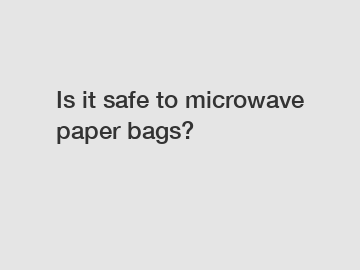Is it safe to microwave paper bags?
Is it safe to microwave paper bags?
Microwaving is a convenient way of heating up or cooking food quickly, but it sometimes raises concerns about the safety of certain containers, such as paper bags. There seems to be a division of opinion on whether it is safe or not to microwave paper bags, with some claiming it is perfectly fine while others warn against it. In this article, we will explore this topic in depth and provide you with all the information you need to decide for yourself.
1. The composition of paper bags:

Paper bags are typically made from paperboard or Kraft paper, which is a type of paper produced by the chemical pulping process. It is relatively heat resistant and can withstand temperatures up to around 500 degrees Fahrenheit. Generally, paper bags are safe to use for their intended purpose, which is carrying and storing groceries or other items. However, when it comes to microwaving, the story may be different.
2. Potential hazards of microwaving paper bags:
There are a few reasons why microwaving paper bags can be risky. First and foremost, microwaves work by emitting electromagnetic waves that excite the water molecules in food, causing them to vibrate and generate heat. This heat is then transferred to the surrounding molecules, which gradually heats up the food. Paper bags, being made of paper, have a high possibility of catching fire if they contain even the slightest traces of oil or grease.
3. Fire hazards and chemical emissions:
Oil and grease are highly flammable substances. If a paper bag with oil or greasy residue is exposed to the heat of the microwave, there is a significant risk of it catching fire. The high heat generated by microwaves can quickly ignite the bag and lead to a fire. Moreover, when paper bags burn, they release toxic gases and chemicals, such as carbon monoxide and dioxins, which can be harmful if inhaled.
4. Safe alternatives for microwaving:
To avoid any potential hazards associated with microwaving paper bags, it is best to opt for safer alternatives. One option is to use microwave-safe glass or ceramic containers. These containers are designed to withstand the high heat generated by microwaves and are less likely to catch fire. Additionally, microwave-safe plastic containers made from BPA-free materials can also be used. It is important to always check the labels of containers and ensure that they are explicitly labeled as microwave-safe.
5. Special paper bags for microwaving:
While regular paper bags are not suitable for microwaving, there are specially designed microwave-safe paper bags available on the market. These bags are typically coated with a layer of heat-resistant material that prevents them from catching fire. However, it is crucial to carefully follow the manufacturer's instructions and guidelines when using these bags to ensure safety. It is worth noting that these specialty bags are often more expensive than regular paper bags.
In conclusion, while paper bags may seem harmless, microwaving them can pose potential risks. The risk of fire, especially when oil or greasy residue is present, should not be taken lightly. To ensure your safety and prevent accidents, it is advised to use microwave-safe containers made of glass, ceramic, or BPA-free plastics. If you absolutely must use paper bags, make sure to obtain specially designed microwave-safe paper bags. Always prioritize safety in the kitchen and stay informed about potential hazards associated with different materials when using them in the microwave.
For more microwave popcorn packaging, popcorn in a brown paper bag, Greaseproof Popcorn paper Baginformation, please contact us. We will provide professional answers.


